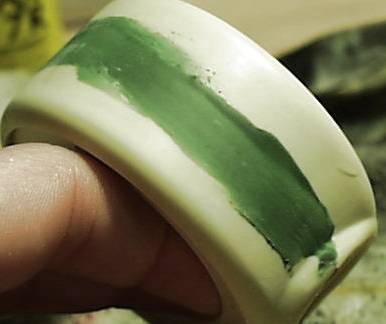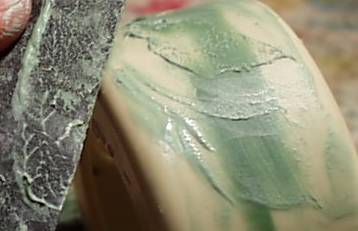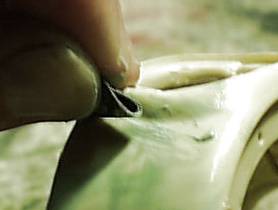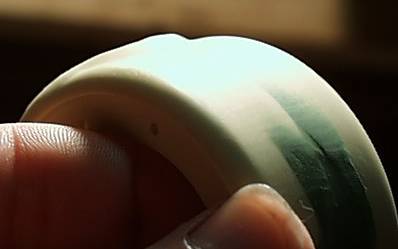If you came directly to this page without looking at the first finishing page, check there for the tools you'll need at hand. For wet-sanding, it also helps to have an old bath towel and some paper towels at hand. I usually wet-sand with the old towel wadded up beneath the part I'm sanding. It catches drips, plus I can quickly wipe off the part to check on sanding progress.
Why wet- instead of dry-sanding? When dry-sanding, the sanded-off particles have nowhere to go except into the grit of your sandpaper. This quickly clogs up the paper, making it ineffective for sanding. When wet-sanding, the particles get suspended in the water. They tend not to get deposited in your sandpaper's grit.
 |
Here's the puttied piece, ready for sanding. The putty has
dried for a week.
Cut out a 2" square of fresh wet-dry sandpaper and fold it into quarters. Fill a cup or other small container about half full of water. Have a small spray-bottle of water handy. Drop the sandpaper into the water and let is soak a bit, until the backing becomes flexible. |
| Begin sanding by using a combination of circular motions and cross-seam motions. Frequently dip your paper in the water, or use your sprayer to wet down the part. | |
|
|
|
Be sure to keep the sanding residue no thicker than a slurry on the paper and part. |
If the sanding residue makes "trees" when you lift the sandpaper away from the part, then it's time to add more water. |
 |
 |
 |
For corners and other tight spots, use a folded edge of paper to sand across the seam there. |
 |
Check your results occasionally by rinsing and drying off
the piece. Hold it between you and a light and look across it. The glare
of light on the piece makes it easy to spot any imperfections in the seam.
When the seam
is properly sanded, you won't be able to see any shadows, indicating high
or low spots on the seam.
Note there are no shadows on the top of the piece here, but you can still see shadows to the right. |
|
|
|
|
|
The Model Citizen's "Sprue U" pages are �2000 Roger Sorensen
page URL: http://employees.csbsju.edu/rsorensen/modelcitizen/sprue_u/150.htm
last updated 04 December, 2007